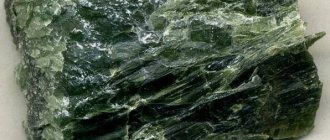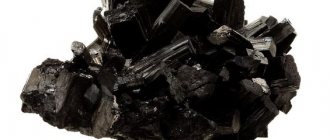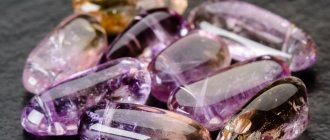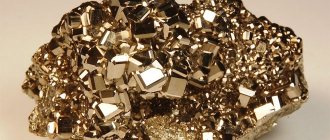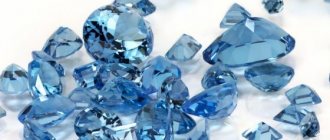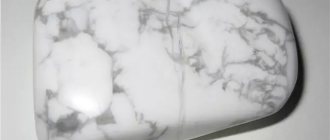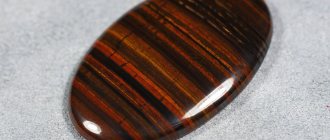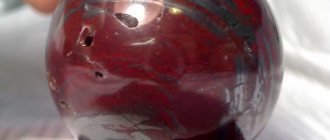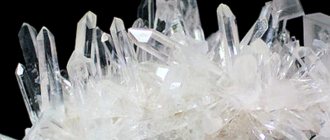The name of the mineral fluorite comes from the Latin fluere - to flow, due to the fusibility of mixtures of various ores with the mineral; this designation has been used for the mineral since the time of Agricola.
English name Fluorite - Fluorite
Fluorite with large gas-liquid inclusions. Kazakhstan.Betnaklala
Physical and chemical properties
The chemical composition of fluorite is calcium fluoride. He is soft and fragile. The mineral melts at a temperature of 1360 degrees, dissolves in hydrochloric acid, and under a blowpipe cracks and melts at the edges. It luminesces in cathode rays and under ultraviolet radiation, glows when heated (thermoluminescence), phosphorescent when heated and irradiated with ultraviolet rays, that is, it is a fluorescent mineral.
This is interesting!
The term “ fluorescence ” was proposed by the English mathematician and physicist John Gabriel Stokes in honor of the already known mineral fluorite. From it also comes the Latin fluorum - the name of the chemical element fluorine. The stone itself received its name “fluorite” in 1529 from the German scientist, father of mineralogy, George Agricola (Georg Paver, Georg Bauer). It comes from the Latin word fluere, which means “to flow” and reflects the behavior of the mineral when heated. Also due to the fact that fluorite melts easily, it is often called “fluorspar.”
| Formula | CaF2 |
| Color | Purple, green, red, cyan, indigo, yellow, colorless, mixed and rainbow |
| Probable impurities | Chlorine, uranium, thorium, iron, rare earth elements |
| Shine | Glass |
| Hardness | 4 |
| Transparency | Mostly transparent |
| Density | 3.18 g/cm3, for yttrium and cerium - 3.3-3.6 g/cm3 |
| Strength | Fragile |
| Melting temperature | 1360 degrees |
| Kink | Stepped, conchoidal |
| Cleavage | Octahedron perfect |
| singonia | Cubic |
| Refractive index | 1,433-1,435 |
The physical and chemical properties of fluorite have led to its use in such industries as:
- Metallurgy – as a flux.
- Chemical industry - for the production of fluorine and a number of fluoride compounds, for the production of hydrofluoric acid.
- In ceramic production - as a component of glazes and enamels for tableware.
- In optics, all kinds of lenses are made from colorless specimens.
- Many other areas.
Mineral mining
Fluorite color varies
Where is the mineral fluorite mined? The deposits are located in different parts of the globe. Most often, its deposits can be found in areas of hydrothermal mines, among limestones and dolomites. A characteristic feature of this natural mineral is the so-called regional coloring, which depends on the deposit. This phenomenon is due to the fact that the color of the crystal depends on the element that is included in its structure. This could be iron, titanium, uranium, chlorine, strontium, copper, etc. In different mines, certain metals predominate, which changes the chemical composition of the crystal and is reflected in the colors of the fluorspar.
The most famous deposits of fluorite stone:
- Germany - Wolsendorf, Lobenstein in Thuringia, Hertz
- Italy - Pars in South Tyrol
- Norway – Kongsberg
- Denmark – Ivingtooth on the island of Greenland
- Britain – Derbyshire
- Canada – Newfoundland
- USA - mines in Illinois
- Tajikistan – Kondomaskoe, Takob
- Kazakhstan – Badamskoe
- Sweden – Falun
- Uzbekistan – Chatkal
- Kyrgyzstan – Khaidarkan
- Russia - Abagaituy and Kalangui in the Chita region, Khuraiskoye and Ara-Tashirskoye in Buryatia, Yaroslavskoye in the Primorsky Territory, Amderminskoye in the Nenets Autonomous Okrug, Tashtagolskoye in Mountain Shoria
- Ukraine – Bakhtinskoe in the Vinnitsa region, deposits in the Donetsk region and Podolia
- Namibia – Okaroso
- South Africa – Buffalo
- Mozambique – Alto Ligonya
Some fluorite deposits, like Derbshire in England, are now depleted and mining has almost ceased. Others are just beginning to develop and have large deposits of fluorite. Each place has its own special type of mineral; experts can even determine the origin of the samples by appearance and chemical composition. What is the mass of the stones? It ranges from a few grams to tens of kilograms. The record holder is a specimen weighing 200 kg, found in the USA.
Colors and varieties
Fluoite is also notable for the fact that it comes in many colors. He can be:
- Colorless, that is, pure calcium fluoride, free of impurities.
- Bright red, blue, yellow, purple, green. Depending on the color scheme, such stones are called false rubies, emeralds, sapphires, amethysts or topazes.
- Two-, three-color or rainbow. The most beautiful and expensive specimens.
Mineralogists distinguish such varieties as:
- Anthozonite (smelly fluorspar, radioflurite). This variety contains uranium as impurities and is therefore radioactive. And when heated or mechanically impacted, it begins to release fluorine, which is accompanied by a characteristic unpleasant odor. This species is characterized by a dark purple color.
Fluorite anthozonite
- Yttrofluorite (calcium is partially replaced by yttrium). Specimens of this species come in yellow, yellow-brown colors.
Yttrofluorite
- Chlorophane, which, due to chlorine impurities, has a rich emerald green color and intensely fluoresces green when heated.
Chlorophane
- Ratovkit. It has an earthy or fine-grained texture, and the pebbles can be pale purple, lilac or pinkish.
Ratovkit
- Blue John (Derbyshire spar) is a stone of blue, blue, violet shades, and may have white and yellowish zones.
Blue John (Derbyshire spar)
Structure [edit]
Main article: Calcium fluoride
Structure of calcium fluoride CaF 2. [10]
Fluorite crystallizes in cubic form. Crystal twinning is common and complicates observed crystal habits. Fluorite has four ideal cleavage planes that help form octahedral fragments. The fluorite structural motif is so common that it is called the fluorite structure. Elemental substitution for the calcium cation often includes certain rare earth elements (REEs) such as yttrium and cerium. Iron, sodium and barium are also common impurities. Some fluoride anions can be replaced by chloride anion.
Magical properties of fluorite
Jewelry with Fluorite stone
The mysterious play of all the colors of the rainbow, the fluidity of shades and the glow of fluorite in the dark have always fascinated people. His magic is development, the future, a huge step forward, and at the same time protection and energy.
According to one of the ancient legends, the ore flower was given to people by the gods so that they, having absorbed its magic, would become kinder to others and overcome cruelty and heartlessness in themselves. It was also believed that the stone, with its light, was able to show the way to a person confused in feelings and lost in the darkness of mistrust.
Legends are legends, but modern magicians and psychics have no doubt that:
- The stone nourishes a person with energy, while taking away all the negativity directed at him.
- It protects its owner from bad influences, psychological pressure and various kinds of addictions.
- The rainbow variety makes a person’s life brighter, filling it with adventure, positive emotions and happiness.
- Green specimens turn pessimists into optimists, lift your spirits and teach you to enjoy every day you live.
- Fluorite greatly enhances intuition, helps to look into the future and establish a connection with the world of spirits.
Sorcerers in the Middle Ages believed that an ore flower was capable of revealing magical abilities in a person, but only if it considered him strong and worthy enough. Otherwise, the stone could even destroy the applicant.
- The mineral gives a person the ability to sense lies, distinguish hypocrisy from sincerity, and self-interest from good intentions.
- It activates a person’s creative nature, helps develop talents and hone skills to a professional level.
- It stimulates the owner to acquire new knowledge, helps to conduct research, analyze, compare and come to the only correct conclusion.
- The ore flower is able to warn a person about impending storms in life, sending him prophetic dreams.
In East Asia, there is still a belief that fluorite is capable of completely reshaping a person’s destiny. They also believe that it makes the magician omnipotent (both good and evil), but only he must completely “grow together” with the luminous stone on the energetic level.
Who is suitable according to their zodiac sign?
If you choose a stone according to your zodiac sign, then it has the most positive effect on Aquarius, Gemini, Libra, Pisces and Capricorn:
- For Libra, the fluorite stone will become protection from envious people and ill-wishers.
- Capricorns will learn to better express their thoughts and defend their beliefs.
- The ideal union would be Gemini and fluorite. It provides them with protection, and also helps them achieve harmony and gain additional strength. The impact on the health of Gemini will also be positive.
- Aquarians will find it easier to cope with life's troubles.
- Pisces will finally decide on the direction of their implementation.
Influence on other signs:
- Enterprising Aries, wearing fluorite, will become calmer and more balanced, and Taurus will experience success in business, in particular in moving up the career ladder.
- Leo will also become calmer, and Virgo will gain mutual understanding with others.
- Scorpios will become more confident in themselves.
- Sagittarius is the only sign for whom wearing or possessing fluorite is not recommended.
Medicinal properties
Blue fluorite
Fluorite has been known to mankind for a long time and its healing power has never been questioned, although it is still believed that the healing properties of the stone have not been fully studied.
In ancient times, there was a belief that water infused with ore flower could cure many diseases.
Modern lithotherapists advise resorting to the help of a luminous stone if:
- There are problems with the cardiovascular system. It helps calm the heartbeat, improve blood flow and reduce blood pressure.
- The balance in the nervous system is disturbed. The stone relieves fears and anxiety, relieves stress and depression, helps normalize sleep and adds endurance to a person in difficult life situations. Meditation with a stone helps you calm down and get rid of obsessive thoughts.
- Weak immunity. Fluorspar increases the body's resistance to viruses, accelerates cell regeneration, and sets the host up for a speedy recovery.
- There is a lack of calcium in the body, which causes the skeletal system, including teeth, to suffer.
- I often get headaches, for example, when the weather changes or magnetic storms. If you move a pebble in a circular motion across your forehead and temples, the pain will soon subside.
- Premature signs of aging have appeared. Facial massage with a fluorite ball promotes rejuvenation.
- There are problems with vision. Wearing a green stone helps restore it.
The use of fluorite together with traditional medicine is also useful in the treatment of epilepsy, senile sclerosis, kidney disease, recovery from stroke and heart attack.
Talismans and amulets
Fluorite crystals
The fame of fluorite as a powerful magical stone has reached our days from ancient times. The sorcerers of that time, using the glow of the stone in the dark, impressed their visitors and even terrified them. Today, fluorescence is a familiar and understandable phenomenon, but the reputation of the ore flower as a powerful amulet has remained unchanged.
Mystics advise wearing a stone:
- People of science and education, as it increases analytical abilities, increases the thirst for knowledge, new discoveries, helps to process information, remember it, make assumptions and draw the right conclusions.
- People of creativity. Fluorite stimulates the awakening of hidden talents and the development of obvious ones. He becomes a muse for creators, helps actors get used to their roles, gives self-confidence to shy people, and guides those who doubt.
- For spiritual people for meditation and enlightenment, as well as for those who need to put their thoughts and feelings in order. Daily contemplation of the color tints in the depths of the stone helps a person find inner harmony.
- People who need to quickly and accurately receive non-verbal messages, for example, mothers, as well as everyone who works with children and animals.
Ore flower greatly enhances a person’s intuition – this quality is useful in many professions.
- For those who spend a lot of time at the computer. In this case, the mineral should be placed somewhere nearby. It will not only absorb electromagnetic radiation, but will also help avoid gambling addiction, as well as the influence of negative information on the Internet. A person will simply not notice it, be distracted by bright pictures and enticing headlines, he will immediately focus only on what is necessary and what will actually bring him some benefit.
- Those who are under someone's influence. Fluorspar will not allow anyone to manipulate the consciousness of its owner.
As for names, fluorite also has its favorites. He especially favors Vera and Evgenia, Polina and Olga, Maria and Svetlana, Anna, Elizaveta and Ksenia. Alin and Catherine, Vasilis and Barbarian do not like the stone. It’s easier for men in this regard; the mineral doesn’t separate them by name.
Links[edit]
This article incorporates public domain material from the USGS document: "Fluorspar" (PDF).
- Anthony, John W.; Bidot, Richard A.; Bladh, Kenneth W.; Nichols, Monte K. (ed.). "Fluorite." Handbook of Mineralogy (PDF). III (halides, hydroxides, oxides). Chantilly, Virginia, USA: Mineralogical Society of America. ISBN 0962209724. Retrieved December 5, 2011.
- ^ a b Fluorite. Mindat.org
- Fluorite. Webmineral.com
- Hurlbut, Cornelius S.; Klein, Cornelis, 1985, Manual of Mineralogy
, pp. 324–325, 20th ed., ISBN 0-471-80580-7 - "Discovery of Fluorine". History of fluorine.
- compiled by Alexander Senning. (2007). Elsevier's Dictionary of Chemoetymology: The Why and Where of Chemical Nomenclature and Terminology. Amsterdam: Elsevier. p. 149. ISBN 978-0-444-52239-9.
- Harper, Douglas. "fluorite". Online Dictionary of Etymology
. - Harper, Douglas. "spar". Online Dictionary of Etymology
. - James Harrell 2012. UCLA Encyclopedia of Egyptology, Gems.
- Greenwood, Norman N.; Earnshaw, Alan (1997). Chemistry of elements
(2nd ed.). Butterworth-Heinemann. ISBN 978-0-08-037941-8. - ^ a b Deere, Washington (2013). Introduction to rock-forming minerals
. London: Mineralogical Society. ISBN 978-0-903056-27-4. OCLC 858884283. - Fluorspar. USGS.gov (2011)
- Fluorspar reactivation from the St. Lawrence mine in St. Lawrence, NL. Burin Minerals Ltd. (April 9, 2009).
- Van Alstine, R. E. (1944). "St. Lawrence Fluorspar Deposits, Newfoundland." Economic Geology
.
39
(2):109. DOI:10.2113/gsecongeo.39.2.109. - Strong, D.F.; Fryer, B.J.; Kerrich, R. (1984). "Origin of St. Lawrence fluorspar deposits as evidenced by fluid inclusions, rare earth elements, and isotopic data." Economic Geology
.
79
(5): 1142. DOI: 10.2113/gsecongeo.79.5.1142. - [1]
- CFI is seeking a new location for a seaport in St. Lawrence, the Netherlands.
- Korbel, P. and Nowak, M. (2002) The Complete Encyclopedia of Minerals
, Book Sales, ISBN 0785815201. - Rickwood, P. C. (1981). "The Largest Crystals" (PDF). American mineralogist
.
66
: 885–907. - "Caldoveiro Mine, Tamesa, Asturias, Spain". mindat.org.
- Hill, Graham; Holman, John (2000). Chemistry in Context
. Nelson Thorns. ISBN 0174482760. - Ford, Trevor D. (1994). "Fluorspar Blue John." Geology today
.
10
(5): 186. DOI: 10.1111/j.1365-2451.1994.tb00422.x. - ^ ab Stokes, G. G. (1852). "On the change in the refraction of light". Philosophical Transactions of the Royal Society of London
.
142
: 463–562. DOI: 10.1098/rstl.1852.0022. - Stokes, G. G. (1853). “On the change in the refraction of light. No. II." Philosophical Transactions of the Royal Society of London
.
143
: 385–396, p. 387. DOI: 10.1098/rstl.1853.0016. JSTOR 108570. S2CID 186207789. - Przibram, K. (1935). "Fluorescence of fluorite and divalent europium ion". Nature
.
135
(3403): 100. Bibcode: 1935Natur.135..100P. DOI: 10.1038/135100a0. S2CID 4104586. - Moffatt, Gillian Elizabeth; Payten, Thomas Bede; Tziminis, Georgios; Prince, Thomas Jacob de; Teixeira, Lewis da Silva; Klansataya, Elizaveta; Ottaway, David John; Smith, Barnaby Whitmore; Spooner, Nigel Anthony (2021-01-07). "Conversion-enhanced fluorescence in naturally occurring calcium fluoride:". Applied Spectroscopy
. DOI: 10.1177/0003702820979052. - McKeever, S. W. S. (1988). Thermoluminescence of solids. Cambridge University Press. clause 9. ISBN 0-521-36811-1.
- Aigueperse, Jean; Paul Mollard; Didier Devillier; Marius Chemla; Robert Faron; Rene Romano; Jean-Pierre Couer (2005). "Inorganic fluorine compounds." Ullman Encyclopedia of Industrial Chemistry
. Weinheim: Wiley-VCH. DOI: 10.1002/14356007.a11_307. ISBN 3527306730. - ^ ab Miller, M. Michael. Fluorspar, USGS Minerals Yearbook 2009
- "Crawford Cup". British museum . Retrieved December 20, 2014.
- "Interactive Abbe diagram". SCHOTT AG. 2022. Retrieved February 20, 2022.
- Rutten, Harry; van Venrooy, Martin (1988). Evaluation and design of telescope optics. Willmann-Bell, Inc.
- Lyman, T. (1914). "Victor Schumann". Astrophysical Journal
.
38
: 1–4. Bibcode: 1914ApJ…. 39…. 1L. DOI: 10.1086/142050. - Capper, Peter (2005). Volumetric crystal growth of electronic, optical and optoelectronic materials. John Wiley and Sons. item 339. ISBN 0-470-85142-2.
- Height, FWD; Oldfield, Ronald Jowett (2000). Photograph under a microscope. Cambridge University Press. item 157. ISBN. 0-521-77096-3.
- Ray, Sydney F. (1999). Scientific Photography and Applied Imaging. Focal Press. pp. 387–388. ISBN 0-240-51323-1.
- First direct evidence that elemental fluorine occurs naturally. Labspaces.net (07/06/2012). Retrieved August 5, 2013.
- Withers, Neil (July 1, 2012) Fluoride Finally Found in Nature | World of Chemistry. Rsc.org.
Products and decorations made of fluorite
Fluorite jewelry
The ore flower is beautiful, unusual and fantastic, which is why it is loved by jewelers. Stones of different colors, shapes and sizes can perfectly coexist in one product. This design looks especially impressive in beads and bracelets.
The cost of jewelry varies greatly. The main components of the price are both the frame material and the color, size and quality of the stone. For example:
- A ring made of nickel silver wire with two inserts - a large fluorite in the rock and a small processed stone - will cost only $15.
- Silver ring with a small square blue stone – $25.
- An unusual ring in the shape of a snake made of silver and multi-tone gold with medium-sized stones – $120.
- Silver and gold plated set (earrings and ring) with purple inserts – $80.
- Gold earrings with blue accents – $400.
- Green stone bracelet – $23.
- Beads made of greenish-bluish stones with gold spaces between them - $700.
Fluorite ring
You can purchase fluorspar in the form of individual pebbles or souvenir items, for example:
- A green fluorite ball with a diameter of 7.5 cm will cost $75.
- An elongated lilac cabochon (4.5*2.5*0.6 cm) – $7.
- Large rainbow pattern - $45.
- Oval green cabochon (4.57 carats) – $10.
External links [edit]
| Wikisource has the text of the 1911 Encyclopædia Britannica article fluorspar . |
| Wikimedia Commons has media related to Fluorite . |
- Educational article about the different colors of fluorite crystals from Asturias, Spain
- Weardale Fluorite Educational Tour
- Illinois State Geological Survey
- Illinois State Mineral
- Barber Cup and Crawford Cup, related Roman cups in the British Museum
| Authoritative control |
|
How to wear fluorite correctly?
The main rule when wearing fluorite is to insulate it from contact with hard objects (the metal of the jewelry frame does not count). If a person just has a pebble, then you can put it in an empty pocket or sew it into the lining of your clothing.
The most friendly to the owner, according to esotericists, are earrings, rings and rings (best worn on the ring finger), where the stone is presented in gold or silver.
Attention!
Necklaces, beads, pendants and everything that is worn around the neck should be worn only on occasion, that is, for a short time. This is important because with prolonged contact with such jewelry, a person quickly falls under the power of fluorite, loses his will and ability to think rationally, goes astray, becomes thoughtful, self-absorbed, or apathetic and depressed.
As for age, there are no restrictions on wearing the stone. Both very young girls and mature ladies can wear jewelry with it.
Taking care of the fragile gem
Jewelry with fluorite (or rather, the stone itself) is extremely capricious. The mineral has low hardness; another problem is its fusibility.
Caring for such jewelry is not easy. They do not tolerate steam and ultrasonic cleaning. Exposure to strong light sources is stress and danger to the crystal, baths and saunas can cause irreparable harm.
An experienced jeweler will not insert fluorite into a ring; pendants, brooches, and earrings are another matter.
However, magicians and sorcerers order rings with fluorite for their “professional” affairs.
How to distinguish an original from a fake
Faceted fluorite
Certain varieties of fluorite can act as imitations of stones such as emerald, ruby, amethyst, topaz and sapphire, although they are much inferior to them in physical terms. And the mineral itself is counterfeited by dishonest jewelers using ordinary glass. It's quite easy to spot a fake:
- Fluorspar is denser and therefore heavier than glass.
- Fluorite has unique properties - it glows in the dark, when heated and under ultraviolet light; this is not observed in fakes.
- Its structure and surface are never ideal - there are always bubbles and notches.
- Natural mineral heats up slowly, but imitations quickly absorb the heat of the human hand.
Source of fluorine gas in nature[edit]
In 2012, the first source of natural fluorine gas was discovered in fluorite mines in Bavaria, Germany. It was previously thought that fluorine gas did not occur naturally because it was so reactive and reacted quickly with other chemicals. [37] Fluorite is usually colorless, but some different forms found nearby appear black and are known as "stinking fluorite" or anthozonite. Minerals containing small amounts of uranium and its daughter products emit radiation powerful enough to cause fluoride anions within the structure to oxidize to fluorine, which becomes trapped within the mineral. The color of foul-smelling fluorite is due primarily to calcium.remaining atoms. Solid state NMR of fluorine-19 performed on the gas contained in anthozonite showed a peak at 425 ppm, corresponding to F 2 . [38]
How to care for stone
From the technical side of the issue, caring for fluorite is simple, that is, it does not need to be cleaned with any special means, polished, and so on. But the stone is soft and very fragile, and therefore requires careful handling. It should not be hit, dropped, exposed to aggressive chemicals or temperature changes (not higher than +40 and not lower than -5).
Contaminants from fluorspar are removed with a soft, damp sponge. And for energetic cleaning, it is periodically rinsed with cool running water.
Jewelry is stored in a soft bag or case without proximity to anything else, because even an ordinary piece of glass with a sharp edge can leave a scratch on the stone.
Images[edit]
- Fluorite crystals on display in the Cullen Hall of Gem and Minerals at the Houston Museum of Natural History
- Fluorite and sphalerite from the Elmwood Mine, Smith County, Tennessee, USA.
- Translucent ball of botryoidal fluorite on a calcite crystal
- Fluorite with barite from the Berbes mine, Berbes mine, Ribadesella, Asturias, Spain
- Fluorite and galena from Rogerley Mine, Weardale, North Pennines, England, UK
- Fluorite from the El Hammam mine, Meknes prefecture, Meknes-Tafilalet region, Morocco
